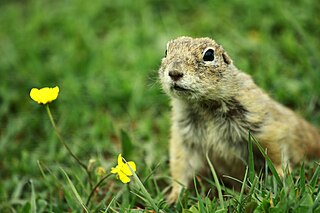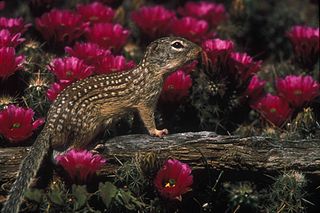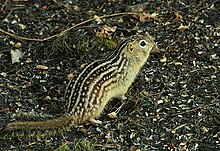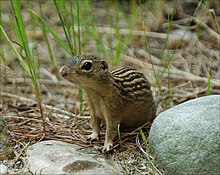
The California ground squirrel, also known as the Beechey ground squirrel, is a common and easily observed ground squirrel of the western United States and the Baja California Peninsula; it is common in Oregon and California and its range has relatively recently extended into Washington and northwestern Nevada. Formerly placed in Spermophilus, as Spermophilus beecheyi, it was reclassified in Otospermophilus in 2009, as it became clear that Spermophilus as previously defined was not a natural (monophyletic) group. A full species account was published for this species in 2016.

Ground squirrels are rodents of the squirrel family (Sciuridae) that generally live on the ground or in burrows, rather than in trees like the tree squirrels. The term is most often used for the medium-sized ground squirrels, as the larger ones are more commonly known as marmots or prairie dogs, while the smaller and less bushy-tailed ground squirrels tend to be known as chipmunks.

Franklin's ground squirrel is a species of squirrel native to North America, and the only member of the genus Poliocitellus. Due to the destruction of prairie, the populations of Franklin's ground squirrel have dwindled, approaching levels of concern. Its decline in the eastern portion of its range is mostly attributed to habitat fragmentation.

Spermophilus is a genus of ground squirrels in the squirrel family. As traditionally defined the genus was very species-rich, ranging through Europe, Asia and North America, but this arrangement was found to be paraphyletic to the certainly distinct prairie dogs, marmots, and antelope squirrels. As a consequence, all the former Spermophilus species of North America have been moved to other genera, leaving the European and Asian species as true Spermophilus.

Heterothermy or heterothermia is a physiological term for animals that vary between self-regulating their body temperature, and allowing the surrounding environment to affect it. In other words, they exhibit characteristics of both poikilothermy and homeothermy.

The Mohave ground squirrel is a species of ground squirrel found only in the Mojave Desert in California. The squirrel was first described in 1886 by Frank Stephens of San Diego. It is listed as a threatened species under the California Endangered Species Act, but not under the federal Endangered Species Act. The IUCN lists this species as near threatened.

The Arctic ground squirrel is a species of ground squirrel native to the Arctic and Subarctic of North America and Asia. People in Alaska, particularly around the Aleutians, refer to them as "parka" squirrels, most likely because their pelt is good for the ruff on parkas and for clothing.

The round-tailed ground squirrel, known as "Ardillón cola redonda" in Spanish, live in the desert of the Southwestern United States and Northwestern Mexico. They are called "ground squirrels" because they burrow in loose soil, often under mesquite trees and creosote bushes.

The tropical ground squirrel is a species of rodent in the family Sciuridae. At one time the species was originally described as Spermophilus adocetus, but the genus Spermophilus was revised and subdivided in 2009 and it was placed in the genus Notocitellus. It is endemic to arid upland areas and deciduous woodland in Mexico. It is locally referred to as Cuinique.
The ring-tailed ground squirrel is a species of rodent in the family Sciuridae. It is endemic to the Pacific coast region of central Mexico. It is a common species and feeds mainly on fruits and nuts. The IUCN has assessed it as being of "least concern".

The Columbian ground squirrel is a species of rodent common in certain regions of Canada and the northwestern United States. It is the second largest member of the genus Urocitellus, which is part of the tribe Marmotini, along with marmots, chipmunks, prairie dogs, and other holarctic ground squirrels. They are stout, with short dense fur, which is characteristically tawny across the bridge of the nose. Social encounters sometimes are initiated with kissing behavior and the most common activity above ground is standing at attention. Residing in mountainous terrain and high plains in northern latitudes, they hibernate for 8 to 9 months of the year in burrows, which may be used for many years. They are emaciated when emerging in the spring. The Columbian ground squirrel came to the attention of the scientific community through writings produced by Lewis and Clark, while 21st century molecular genetics has more finely illuminated its ties with other close relatives.

The Mexican ground squirrel is a species of rodent in the family Sciuridae. It is found in Mexico and the United States. One of its closest relatives is the thirteen-lined ground squirrel.

The Cascade golden-mantled ground squirrel is a species of rodent in the family Sciuridae, in the order Rodentia. It is the largest species of the three within the genus Callospermophilus. It is found in the Cascade Mountains in the province of British Columbia, Canada and the state of Washington, United States.

The spotted ground squirrel is a species of ground squirrel in the rodent family Sciuridae. It is found throughout Mexico and the central and western United States. Characterized by a white spotted back, the spotted ground squirrel is one of the smallest squirrels found in North America. They are mainly herbivorous, but also eat insects. A burrowing mammal, the spotted ground squirrel will make tunnels to store its food, as well as shelter and hibernation quarters.

The rock squirrel is a species of rodent in the family Sciuridae. It is native to Mexico and the Southwestern United States, including southern Nevada, Utah, Colorado, Arizona, New Mexico, West Texas, and the panhandle of Oklahoma.

The Asia Minor ground squirrel, also known as Anatolian souslik, Anatolian ground squirrel, is a species of rodent in the family Sciuridae. It is found in Armenia, Iran, and Turkey. The scientific name roughly translates as "seed-lover with yellow underparts".

Pygmy ground squirrels are small ground squirrels in the genus Xerospermophilus, family Sciuridae, containing four species from Mexico and the United States. The members of this genus were formerly placed in the large ground squirrel genus Spermophilus. Since DNA sequencing of the cytochrome b gene showed that Spermophilus was paraphyletic to the prairie dogs and marmots, this group is now separated, along with six other genera. Within the genus, the Mohave ground squirrel and the round-tailed ground squirrel were thought to be close relatives, sometimes a subgenus Xerospermophilus, while the spotted ground squirrel and the Perote ground squirrel were formerly placed in the subgenus Ictidomys.
Striped ground squirrel may refer to the following squirrels:

Ictidomys is a North American genus of rodent in the squirrel family, which contains the thirteen-lined ground squirrel, the Mexican ground squirrel, and the Rio Grande ground squirrel. These species were included in the species-rich ground squirrel genus Spermophilus until molecular data showed that this genus was not a natural, monophyletic grouping.

The Rio Grande ground squirrel is a species of squirrel in the family Sciuridae. It is found in the south-western United States and in north-eastern Mexico.





















